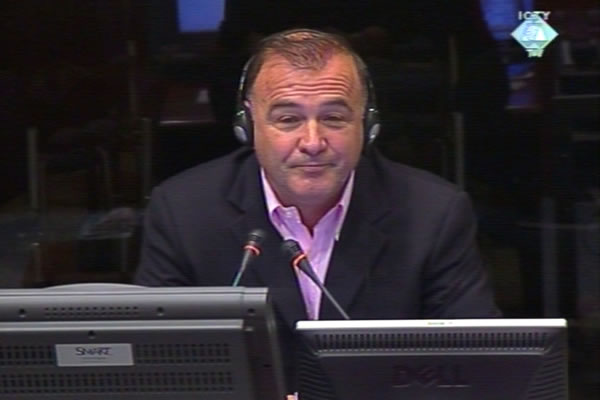Home
KARADZIC’S PICTURE OF WARTIME SARAJEVO
In the final part of his cross-examination of the former member of UNPROFOR French contingent, Karadzic contends that there was ‘chaos’ in Sarajevo and not an ‘idyll” as the prosecution is trying to present in court. In Karadzic’s words, the city was ‘full of soldiers, arms and criminals’ and citizens of all ethnicities were terrorized. This ‘greatly influenced the behavior’ of the Serb side in the conflict. Momcilo Mandic began his evidence today
 Momčilo Mandic, witness at the Radovan Karadzic trial
Momčilo Mandic, witness at the Radovan Karadzic trial Completing his cross-examination of the protected prosecution witness KDZ-185, Radovan Karadzic argued that the ‘Muslim side’ – the term Karadzic uses for the BH Army – resorted to ‘ruses of war’ provoking Serbs to open fire on Sarajevo to ‘denigrate the Serb side in the eyes of the international public’. The witness said that he ‘was aware of those tricks’ because sometimes the peace-keepers ‘were indirect victims’ of such incidents.
In an effort to make the witness confirm his argument more precisely, Karadzic brought up letters of protest that generals Nambiar and Morillon sent to Alija Izetbegovic, president of the BH presidency, after fire was opened on the airport runway and positions held by the UN peace-keepers. The witness said that he was ‘not surprised’ and that something like that ‘could well have happened’.
Karadzic went on to quote a Sarajevo-Romanija Corps document stating that UNPROFOR ‘is supplying Turks with ammunition’ in Sarajevo. The witness said that the peace-keepers knew that the warring sides were ‘paranoid’. Karadzic’s claim, the witness noted, is a ‘good example of that paranoia’. Karadzic then put it to the witness that explosives were brought into the city in oxygen tanks. The witness confirmed that there was one such incident. As far as the witness knew, it didn’t happen again.
Karadzic argued that there was ‘chaos’ in Sarajevo and not an ‘idyll’, as the prosecution is trying to present in court. In Karadzic’s words, the city was ‘full of soldiers, arms and criminals’ and citizens of all ethnicities were terrorized. This ‘significantly influenced the behavior’ of the Serb side in the conflict. Karadzic corroborated this argument with Jovan Divjak’s statement of reasons for his resignation as deputy chief of staff in the BH Army supreme command in May 1993. Commenting on the letter, the witness said it was to Divjak’s credit.
Karadzic then accused the witness of ‘being wary of making assessments and speculations’ about the defense arguments; according to Karadzic, the witness replied to the prosecution’s questions with far more alacrity and was ready to confirm that Sarajevo was held under siege by the Serb side. According to Karadzic, Sarajevo was a ‘divided’ city where the indigenous people held the lines on the Serb side to protect their settlements; the lines were not held by some people who had come from somewhere else.
The witness noted that he was ‘not a historian’ and couldn’t say anything about the indigenous population. As for the issue of ‘siege or encirclement’, the witness explained that in Sarajevo there were confrontation lines, and the two sides held positions along them. ‘The people who were outside held those inside under siege’, the witness explained.
Momcilo Mandic was called as the next witness. Mandic is former justice minister in Radovan Karadzic’s war government. Before he started giving evidence Mandic complained of the problems he had had over the past years with the authorities and judicial organs in Serbia, Montenegro and BH, and with the OTP investigators, who ‘persecuted’ him because they suspected him of assisting Karadzic to hide from international justice. This is why Mandic has asked to be called as a witness of the court, instead of testifying for the prosecution. The Trial Chamber decided that the party that called him as a witness, the prosecution, would be the first to examine Mandic, whose evidence continues tomorrow.
Linked Reports
- Case : Karadzic
- 2010-06-29 KARADZIC’S ‘ACCURATE AND DETAILED EVIDENCE’
- 2010-06-28 MAINTAINING ATMOSPHERE OF TERROR IN SARAJEVO
- 2010-06-23 WHAT THE WITNESS ‘HAD TO KNOW’
- 2010-07-01 DID EXTREMISTS ‘CURRY FAVOR’ WITH KARADZIC OR KRAJISNIK?
- 2010-07-05 MANDIC VS. PLAVSIC: ‘DOCTOR FOR SNAILS ANS WILD ANIMALS’
- 2010-07-06 MISTER PRESIDENT AND MISTER MINISTER
